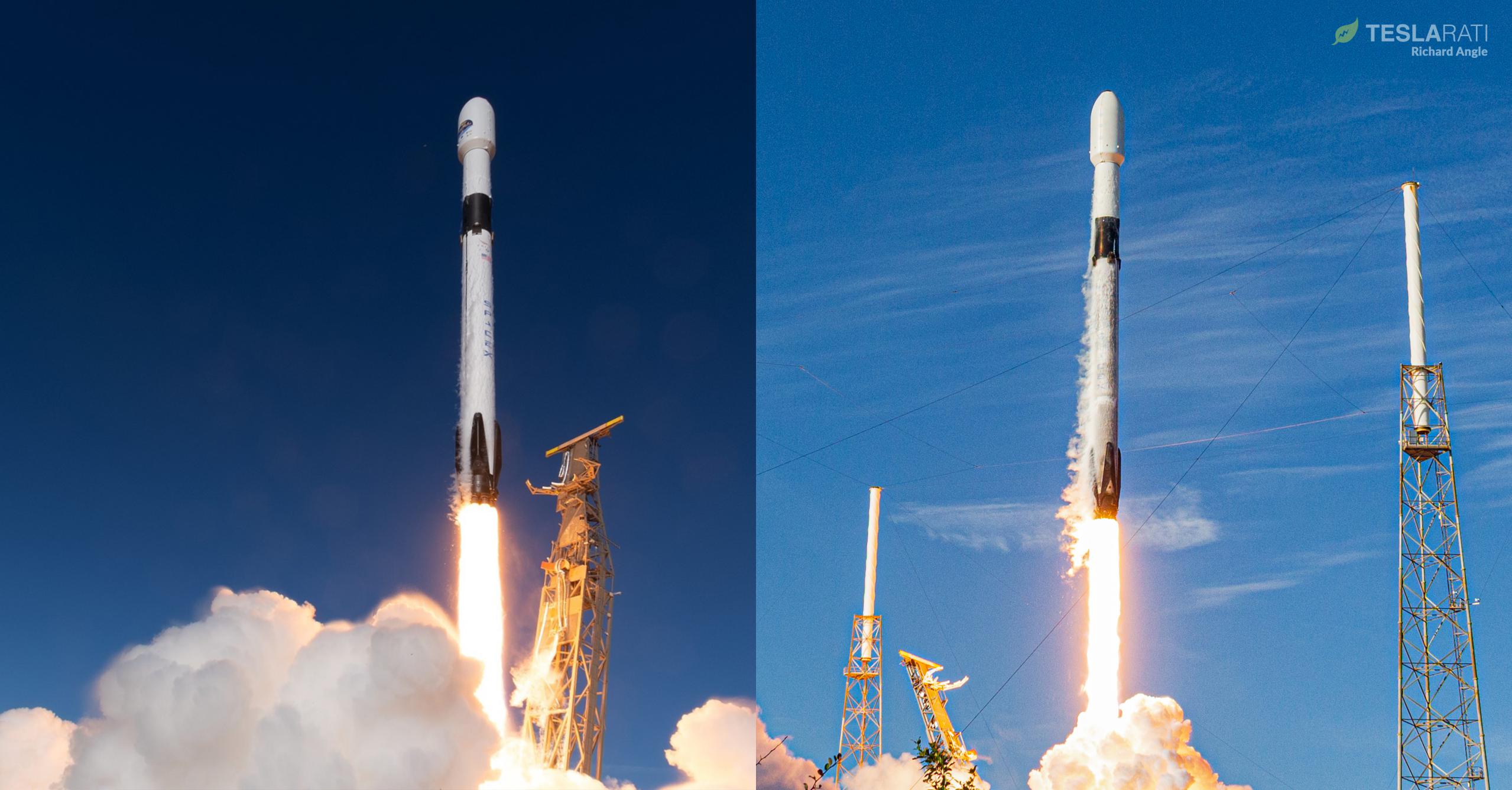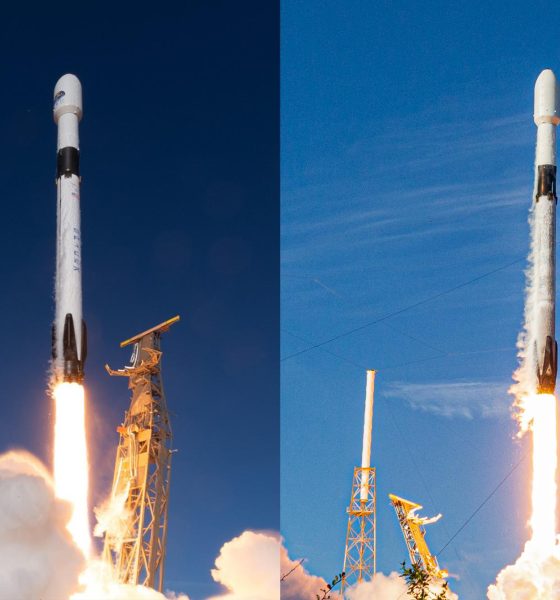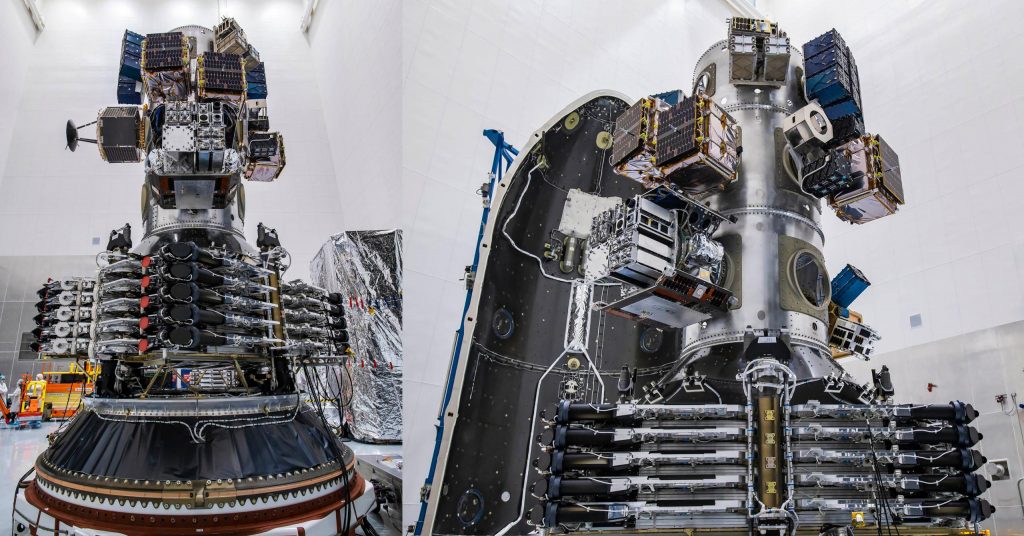

News
SpaceX preparing salvo of polar Starlink launches from West and East coasts
SpaceX has unexpectedly filed regulatory documents requesting permission to perform at least half a dozen polar Starlink satellite launches from its East Coast facilities, hinting at a two-pronged approach as work continues to reactive SpaceX’s lone West Coast launch pad.
Known as Space Launch Complex 4 (SLC-4), SpaceX last used its Vandenberg Air/Space Force Base (VAFB) pad to launch a joint primarily European Earth observation satellite in November 2020 – itself the site’s first launch since June 2019. In April 2021, comments made by SpaceX President and COO Gwynne Shotwell revealed plans to return its VAFB site to active use as early as “summer” 2021 – July, in other words.
Over the next two months, a new Port of Long Beach lease for West Coast drone ship operations, FCC launch application requests, and the westbound shipment of a Falcon 9 booster strongly supported Shotwell’s claim. Most recently, drone ship Of Course I Still Love You (OCISLY) completed the first leg of its journey from Florida to California, arriving at the Panama Canal’s Atlantic locks on June 20th. That progress has all but guaranteed that SpaceX’s West Coast launch resurgence will have a drone ship to support booster recoveries – pad, rocket, and satellites permitting – well before the end of July.
Now, though, new SpaceX FCC permit applications suggest that the company intends to begin dedicated polar launches from the East Coast as early as July 26th. That means that SpaceX could theoretically complete its first two dedicated polar Starlink launches next month if things go smoothly. Given that SpaceX’s East Coast launch facilities are already active and have been running like a well-oiled machine over the last ~12 months, plans to simultaneously begin polar Starlink launches from the East and West coasts could also serve as a hedge against any delays that might crop up while reactivating SLC-4E.
In the event of delays, SpaceX would thus still have a feasible path to complete its first dedicated polar Starlink launch before the end of the month, potentially leaving it on track to complete around a dozen such missions before the end of the year.
Just last month, Starlink passed a major milestone with SpaceX’s 28th successful launch of v1.0 satellites, effectively completing the constellation’s first orbital ‘shell’ of ~1600 spacecraft. Technically, around 1100 of those satellites are operational and the other ~530 are still in the processing of boosting themselves to their final orbits, but that’s just a matter of time. Once all of spacecraft already in orbit complete that process, the Starlink constellation will be able to deliver uninterrupted internet to almost anybody on Earth.
Another identical semi-equatorial batch of ~1584 satellites is planned to flesh out the Starlink Phase 1 constellation and improve bandwidth density but to achieve true global coverage, another ~1250 polar Starlink satellites are necessary. In Starlink’s first ~4400-satellite phase, those polar-orbiting spacecraft are split between three ‘shells’ with slightly different orbits and inclinations to increase the breadth of their coverage as much as possible. Notably, polar Starlink satellites will offer truly uninterrupted coverage anywhere on Earth – not just land-based users outside of polar latitudes.

With laser interlinks installed, those polar satellites will also allow Starlink to break into the lucrative in-flight and maritime communications markets and serve unprecedentedly high-quality internet to people in the air and at sea. They’ll also open up Starlink to many of the four million or so people living in the Arctic Circle.
While East Coast polar Starlink launches will be less efficient and likely have to carry fewer satellites, simultaneously flying from the East and West Coast could allow SpaceX to launch the constellation’s ~1250 polar satellites in just 12-18 months while still performing regular equatorial launches at the same time.

News
Tesla FSD fleet is nearing 7 billion total miles, including 2.5 billion city miles
As can be seen on Tesla’s official FSD webpage, vehicles equipped with the system have now navigated over 6.99 billion miles.

Tesla’s Full Self-Driving (Supervised) fleet is closing in on almost 7 billion total miles driven, as per data posted by the company on its official FSD webpage.
These figures hint at the massive scale of data fueling Tesla’s rapid FSD improvements, which have been quite notable as of late.
FSD mileage milestones
As can be seen on Tesla’s official FSD webpage, vehicles equipped with the system have now navigated over 6.99 billion miles. Tesla owner and avid FSD tester Whole Mars Catalog also shared a screenshot indicating that from the nearly 7 billion miles traveled by the FSD fleet, more than 2.5 billion miles were driven inside cities.
City miles are particularly valuable for complex urban scenarios like unprotected turns, pedestrian interactions, and traffic lights. This is also the difference-maker for FSD, as only complex solutions, such as Waymo’s self-driving taxis, operate similarly on inner-city streets. And even then, incidents such as the San Francisco blackouts have proven challenging for sensor-rich vehicles like Waymos.
Tesla’s data edge
Tesla has a number of advantages in the autonomous vehicle sector, one of which is the size of its fleet and the number of vehicles training FSD on real-world roads. Tesla’s nearly 7 billion FSD miles then allow the company to roll out updates that make its vehicles behave like they are being driven by experienced drivers, even if they are operating on their own.
So notable are Tesla’s improvements to FSD that NVIDIA Director of Robotics Jim Fan, after experiencing FSD v14, noted that the system is the first AI that passes what he described as a “Physical Turing Test.”
“Despite knowing exactly how robot learning works, I still find it magical watching the steering wheel turn by itself. First it feels surreal, next it becomes routine. Then, like the smartphone, taking it away actively hurts. This is how humanity gets rewired and glued to god-like technologies,” Fan wrote in a post on X.
News
Tesla starts showing how FSD will change lives in Europe
Local officials tested the system on narrow country roads and were impressed by FSD’s smooth, human-like driving, with some calling the service a game-changer for everyday life in areas that are far from urban centers.

Tesla has launched Europe’s first public shuttle service using Full Self-Driving (Supervised) in the rural Eifelkreis Bitburg-Prüm region of Germany, demonstrating how the technology can restore independence and mobility for people who struggle with limited transport options.
Local officials tested the system on narrow country roads and were impressed by FSD’s smooth, human-like driving, with some calling the service a game-changer for everyday life in areas that are far from urban centers.
Officials see real impact on rural residents
Arzfeld Mayor Johannes Kuhl and District Administrator Andreas Kruppert personally tested the Tesla shuttle service. This allowed them to see just how well FSD navigated winding lanes and rural roads confidently. Kruppert said, “Autonomous driving sounds like science fiction to many, but we simply see here that it works totally well in rural regions too.” Kuhl, for his part, also noted that FSD “feels like a very experienced driver.”
The pilot complements the area’s “Citizen Bus” program, which provides on-demand rides for elderly residents who can no longer drive themselves. Tesla Europe shared a video of a demonstration of the service, highlighting how FSD gives people their freedom back, even in places where public transport is not as prevalent.
What the Ministry for Economic Affairs and Transport says
Rhineland-Palatinate’s Minister Daniela Schmitt supported the project, praising the collaboration that made this “first of its kind in Europe” possible. As per the ministry, the rural rollout for the service shows FSD’s potential beyond major cities, and it delivers tangible benefits like grocery runs, doctor visits, and social connections for isolated residents.
“Reliable and flexible mobility is especially vital in rural areas. With the launch of a shuttle service using self-driving vehicles (FSD supervised) by Tesla in the Eifelkreis Bitburg-Prüm, an innovative pilot project is now getting underway that complements local community bus services. It is the first project of its kind in Europe.
“The result is a real gain for rural mobility: greater accessibility, more flexibility and tangible benefits for everyday life. A strong signal for innovation, cooperation and future-oriented mobility beyond urban centers,” the ministry wrote in a LinkedIn post.
News
Tesla China quietly posts Robotaxi-related job listing
Tesla China is currently seeking a Low Voltage Electrical Engineer to work on circuit board design for the company’s autonomous vehicles.

Tesla has posted a new job listing in Shanghai explicitly tied to its Robotaxi program, fueling speculation that the company is preparing to launch its dedicated autonomous ride-hailing service in China.
As noted in the listing, Tesla China is currently seeking a Low Voltage Electrical Engineer to work on circuit board design for the company’s autonomous vehicles.
Robotaxi-specific role
The listing, which was shared on social media platform X by industry watcher @tslaming, suggested that Tesla China is looking to fill the role urgently. The job listing itself specifically mentions that the person hired for the role will be working on the Low Voltage Hardware team, which would design the circuit boards that would serve as the nervous system of the Robotaxi.
Key tasks for the role, as indicated in the job listing, include collaboration with PCB layout, firmware, mechanical, program management, and validation teams, among other responsibilities. The role is based in Shanghai.
China Robotaxi launch
China represents a massive potential market for robotaxis, with its dense urban centers and supportive policies in select cities. Tesla has limited permission to roll out FSD in the country, though despite this, its vehicles have been hailed as among the best in the market when it comes to autonomous features. So far, at least, it appears that China supports Tesla’s FSD and Robotaxi rollout.
This was hinted at in November, when Tesla brought the Cybercab to the 8th China International Import Expo (CIIE) in Shanghai, marking the first time that the autonomous two-seater was brought to the Asia-Pacific region. The vehicle, despite not having a release date in China, received a significant amount of interest among the event’s attendees.








